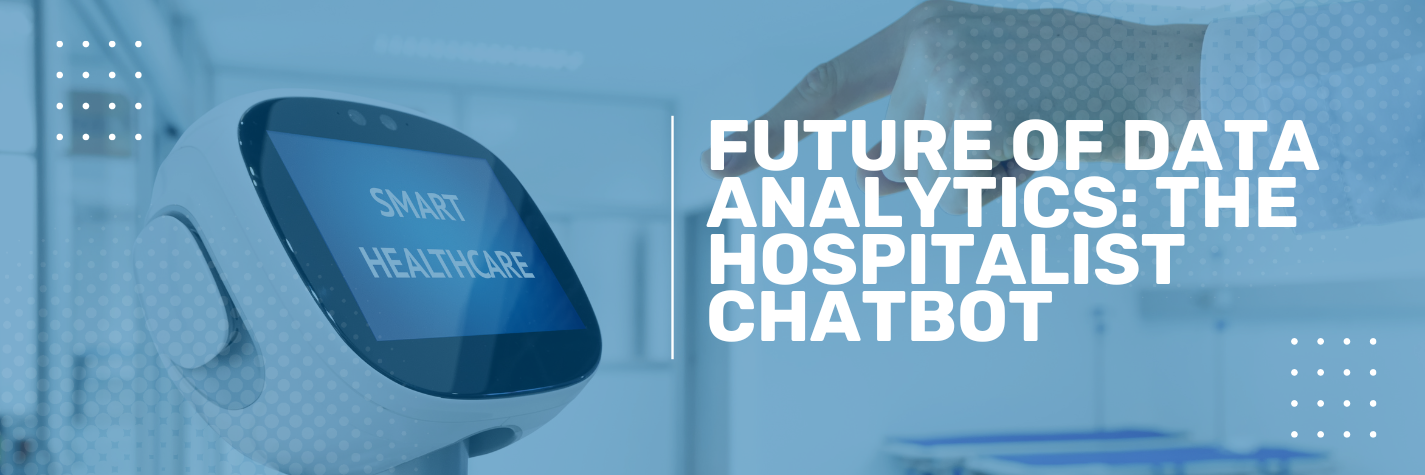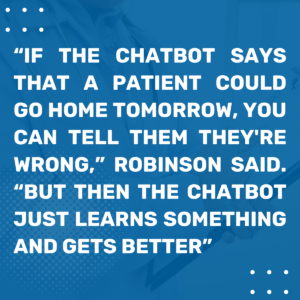![]() Imagine the contributions of an AI sitting in on multidisciplinary rounds
Imagine the contributions of an AI sitting in on multidisciplinary rounds
Note: this is the first in a series about how AI and data analytics will impact the future of emergency and hospital medicine.
You may have heard? Our AI overlords are finally here, and they have come in the form of chatbots.
There are moody chatbots who question their role in the universe and literary chatbots who will write a Shakespearean sonnet on a topic of your choosing. There are chatbots to synthesize millions of pages of academic literature, write your social media posts, suggest topics for your next screenplay, and everything in-between.
At a recent meeting of the Georgia Association of Healthcare Executives (GAHE), Core CEO Dr. Boykin Robinson pointed to another use case: a chatbot that could sit in on multidisciplinary rounds in a hospital.
Why might you want an AI chatbot involved in multidisciplinary rounds?
First, a recap: many progressive hospitals have recognized the importance of good communication among different providers and between different departments within a hospital. Better communication and collaboration leads to better patient care, leads to improved patient flow, and a more efficient inpatient setting.
Multidisciplinary rounds (also known as interdisciplinary rounds) are intended to facilitate this communication. One typical model is to have an 8 am huddle, where the hospitalist, nursing, case management, and relevant specialists gather together to discuss which patients might be able to be discharged that day. Then, later that day another huddle is held at around 2 pm to discuss who could potentially be discharged the next morning.
Multidisciplinary rounds have shown to have a host of benefits, but one of the issues is that they are essentially dependent on the skills and experience of the hospitalist who is running the meeting. “They’re doing a good job, but they are making these decisions based on what’s in their head, what they’ve seen, their own experience,” said Robinson. “It’s essentially just what they think.”
To be sure, hospitalists are usually pretty good at combining their medical education and training, their real-world experience, and their innate, human capacity for pattern recognition to make judgments about which patients may or may not be able to go home on any given day in a hospital.
Yet AI-driven predictive analytics could be helping make those decisions not based on one doctor’s experience, but based on millions of different inpatients who have come before, in millions of different situations.
A hospitalist chatbot could enter a multidisciplinary round meeting having surveyed the current patients in the hospital, knowing about their disease process, already knowing what major studies have been ordered, when those studies were scheduled for, what the typical turnaround times are, and the probability of each potential result in helping to determine discharge.
Of course, a hospitalist is always free to disagree. “If the chatbot says that a patient could go home tomorrow, you can tell them they’re wrong,” Robinson said. “But then the chatbot just learns something and gets better.”
This is a huge part of the strength of these tools: they are endless learning machines. They don’t get tired or burned out after months or years of 7 on, 7 off shifts—although they are aware that hospitalists can get tired and burned out, and assist accordingly with decision-making.
Ultimately, the recent advances in AI should be exciting for doctors and hospital leaders alike. Chatbots like the one described here will be able to support hospitals to deliver better, more efficient patient care. And, they will help doctors make better decisions while reducing their cognitive loads.
Stay tuned for more!


 Imagine the contributions of an AI sitting in on multidisciplinary rounds
Imagine the contributions of an AI sitting in on multidisciplinary rounds